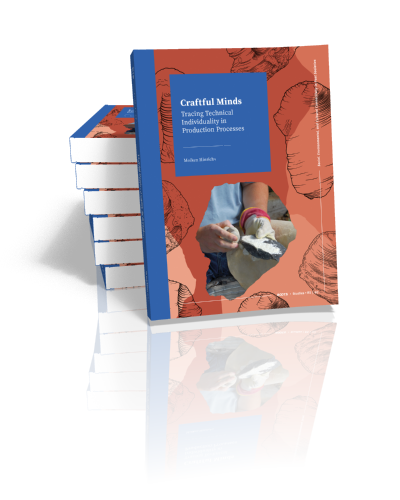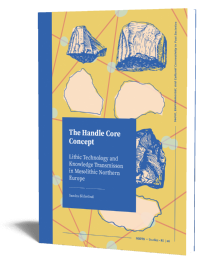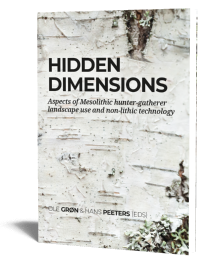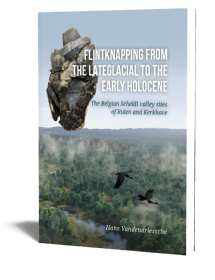Craftful Minds
Tracing Technical Individuality in Production Processes
Moiken Hinrichs | 2024

Craftful Minds
Tracing Technical Individuality in Production Processes
Moiken Hinrichs | 2024
Paperback ISBN: 9789464280814 | Hardback ISBN: 9789464280821 | Imprint: Sidestone Press Dissertations | Format: 210x280mm | 266 pp. | ROOTS Studies 07 | Series: ROOTS Studies | Language: English | 18 illus. (bw) | 140 illus. (fc) | Keywords: prehistoric archaeology; neolithic; flint technology; bifacial production; chaîne opératoire; statistical analysis; daggers; sickles | download cover | DOI: 10.59641/t2780wf | CC-license: CC BY 4.0
Read online or downloaded 637 times
-
Digital & Online access
This is a full Open Access publication, click below to buy in print, browse, or download for free.
-
Buy via Sidestone (EU & UK)
-
Buy via our Distributors (WORLD)
For non-EU or UK destinations you can buy our books via our international distributors. Although prices may vary this will ensure speedy delivery and reduction in shipping costs or import tax. But you can also order with us directly via the module above.
UK international distributor
USA international distributor
-
Bookinfo
Paperback ISBN: 9789464280814 | Hardback ISBN: 9789464280821 | Imprint: Sidestone Press Dissertations | Format: 210x280mm | 266 pp. | ROOTS Studies 07 | Series: ROOTS Studies | Language: English | 18 illus. (bw) | 140 illus. (fc) | Keywords: prehistoric archaeology; neolithic; flint technology; bifacial production; chaîne opératoire; statistical analysis; daggers; sickles | download cover | DOI: 10.59641/t2780wf | CC-license: CC BY 4.0
Read online or downloaded 637 times

We will plant a tree for each order containing a paperback or hardback book via OneTreePlanted.org.
The aim of the thesis was to provide a framework for the identification and analysis of individual craftspeople in bifacial flint production. Flint production flakes from replications of South Scandinavian Late Neolithic daggers and Early Bronze Age sickles were the focus of the study, in contrast to research so far, mostly relying on finished and often exceptional pieces.
To identify technical traditions within technological systems and/or personal approaches to production, it is necessary to analyse the complete production process. Studies concerned with the process have mostly relied on typical and easy to identify production flakes. This facilitates the identification of tool manufacture and prevents mixing with other production processes, but it also prevents the actual identification of individual approaches to bifacial flint production. Typical flint flakes are typical because physical laws restrict the mode of possible removal. They are, by definition, strategic moments in the production process, which cannot be changed without altering the outcome, so everyone has to work the flint in more or less the same way. Personal or traditional approaches will not be found there, but in the small, flexible steps in between. This is what the volume presents.
By detailed analysis of the working procedures of modern knappers, combined with statistical analysis of technical attributes on the production flakes, the possibilities for identification of differing approaches are explored. The analysis shows that the differences on personal or traditional levels are not to be found in the process of removal, but are more clearly distinguished in the preparation for removal. Likewise, the preferences for certain working techniques can be reconstructed and used to distinguish between knappers’ approaches. The results and the approach of the thesis can help us gain a clearer picture of local technical traditions of flint production. They also provide opportunities to identify and analyse processes of knowledge transmission and by this to reconstruct possible paths of learning, contacts between groups and the development and change of technological systems.
Contents
Preface of the series editors
Acknowledgements
Abstract
Chapter 1: Introduction
Chapter 2: A short history of research
2.1 Development of flint technology research in general
2.2 Research on Late Neolithic bifacial tools
Chapter 3: Theory, method and terminology
3.1 Theory
3.1.1 Technique and technology
3.1.2 Transmission of knowledge
3.2 Method
3.2.1 Experiments in archaeology
3.2.2 The recording system
3.2.3 Implementation of statistics in the analysis
Chapter 4: Production sequences in action
4.1 Ideal production sequence
4.2 Individual working procedures
4.2.1 Greg Nunn
4.2.2 Andreas Benke
4.2.3 Peter Wiking
4.3 Observed differences from documentation
4.4 Observed differences on knapping products
4.5 Conclusion
Chapter 5: Statistical analysis
5.1 The inventories
5.2 The raw material
5.3 Reconstructing production stages
5.4 Technical differences in production
5.4.1 Preparation before the strike
5.4.2 Tracing differences in the application of techniques
5.5 Summarising the analyses
5.6 Simulating archaeological assemblages
5.6.1 Single-knapper features
5.6.2 Single-knapper against pure mixed features
5.6.3 Single-knapper against ‘messy’ mixed features
5.6.4 Mixed features
5.7 Summing up the results
Chapter 6: Summary and perspective of results
Chapter 7: Summary in German /Deutsche Zusammenfassung
7.1 Einleitung
7.2 Forschungsgeschichte
7.2.1 Generelle Entwicklung von Forschung zur Flinttechnologie
7.2.2 Forschung zu spätneolithischen bifaziellen Geräten
7.3 Theorie, Methode und Terminologie
7.3.1 Theoretischer Hintergrund
7.3.2 Methodischer Hintergrund
7.4 Produktionssequenzen in Aktion
7.4.1 Die Ideale Produktionssequenz
7.4.2 Unterschiede in den individuellen Produktionssequenzen
7.4.3 Beobachtete Unterschiede an Abschlagsprodukten
7.5 Statistische Analyse der Daten
7.5.1 Die Inventare
7.5.2 Das Rohmaterial
7.5.3 Rekonstruktion von Produktionsphasen
7.5.4 Technische Unterschiede während der Produktion
7.6 Zusammenfassung und Perspektive der Resultate
References
Appendix
Glossary
Dr. Moiken Hinrichs
Moiken Hinrichs studied Pre- and Protohistory at Kiel University. During that time, she worked as a student and a research assistant in different projects of the CRC ‘1266 – Scales of Transformation’ and for the Centre for Baltic and Scandinavian Archaeology, Schleswig. She prepared her PhD in the Cluster of Excellence ROOTS, finishing the project with the thesis Craftful Minds – Tracing Technical Individuality in Production Processes. Her main research interests are flint technology and knowledge transmission, especially in Late Palaeolithic Northern Europe.
Abstract:
The aim of the thesis was to provide a framework for the identification and analysis of individual craftspeople in bifacial flint production. Flint production flakes from replications of South Scandinavian Late Neolithic daggers and Early Bronze Age sickles were the focus of the study, in contrast to research so far, mostly relying on finished and often exceptional pieces.
To identify technical traditions within technological systems and/or personal approaches to production, it is necessary to analyse the complete production process. Studies concerned with the process have mostly relied on typical and easy to identify production flakes. This facilitates the identification of tool manufacture and prevents mixing with other production processes, but it also prevents the actual identification of individual approaches to bifacial flint production. Typical flint flakes are typical because physical laws restrict the mode of possible removal. They are, by definition, strategic moments in the production process, which cannot be changed without altering the outcome, so everyone has to work the flint in more or less the same way. Personal or traditional approaches will not be found there, but in the small, flexible steps in between. This is what the volume presents.
By detailed analysis of the working procedures of modern knappers, combined with statistical analysis of technical attributes on the production flakes, the possibilities for identification of differing approaches are explored. The analysis shows that the differences on personal or traditional levels are not to be found in the process of removal, but are more clearly distinguished in the preparation for removal. Likewise, the preferences for certain working techniques can be reconstructed and used to distinguish between knappers’ approaches. The results and the approach of the thesis can help us gain a clearer picture of local technical traditions of flint production. They also provide opportunities to identify and analyse processes of knowledge transmission and by this to reconstruct possible paths of learning, contacts between groups and the development and change of technological systems.
Contents
Contents
Preface of the series editors
Acknowledgements
Abstract
Chapter 1: Introduction
Chapter 2: A short history of research
2.1 Development of flint technology research in general
2.2 Research on Late Neolithic bifacial tools
Chapter 3: Theory, method and terminology
3.1 Theory
3.1.1 Technique and technology
3.1.2 Transmission of knowledge
3.2 Method
3.2.1 Experiments in archaeology
3.2.2 The recording system
3.2.3 Implementation of statistics in the analysis
Chapter 4: Production sequences in action
4.1 Ideal production sequence
4.2 Individual working procedures
4.2.1 Greg Nunn
4.2.2 Andreas Benke
4.2.3 Peter Wiking
4.3 Observed differences from documentation
4.4 Observed differences on knapping products
4.5 Conclusion
Chapter 5: Statistical analysis
5.1 The inventories
5.2 The raw material
5.3 Reconstructing production stages
5.4 Technical differences in production
5.4.1 Preparation before the strike
5.4.2 Tracing differences in the application of techniques
5.5 Summarising the analyses
5.6 Simulating archaeological assemblages
5.6.1 Single-knapper features
5.6.2 Single-knapper against pure mixed features
5.6.3 Single-knapper against ‘messy’ mixed features
5.6.4 Mixed features
5.7 Summing up the results
Chapter 6: Summary and perspective of results
Chapter 7: Summary in German /Deutsche Zusammenfassung
7.1 Einleitung
7.2 Forschungsgeschichte
7.2.1 Generelle Entwicklung von Forschung zur Flinttechnologie
7.2.2 Forschung zu spätneolithischen bifaziellen Geräten
7.3 Theorie, Methode und Terminologie
7.3.1 Theoretischer Hintergrund
7.3.2 Methodischer Hintergrund
7.4 Produktionssequenzen in Aktion
7.4.1 Die Ideale Produktionssequenz
7.4.2 Unterschiede in den individuellen Produktionssequenzen
7.4.3 Beobachtete Unterschiede an Abschlagsprodukten
7.5 Statistische Analyse der Daten
7.5.1 Die Inventare
7.5.2 Das Rohmaterial
7.5.3 Rekonstruktion von Produktionsphasen
7.5.4 Technische Unterschiede während der Produktion
7.6 Zusammenfassung und Perspektive der Resultate
References
Appendix
Glossary
Dr. Moiken Hinrichs
Moiken Hinrichs studied Pre- and Protohistory at Kiel University. During that time, she worked as a student and a research assistant in different projects of the CRC ‘1266 – Scales of Transformation’ and for the Centre for Baltic and Scandinavian Archaeology, Schleswig. She prepared her PhD in the Cluster of Excellence ROOTS, finishing the project with the thesis Craftful Minds – Tracing Technical Individuality in Production Processes. Her main research interests are flint technology and knowledge transmission, especially in Late Palaeolithic Northern Europe.
-
Digital & Online access
This is a full Open Access publication, click below to buy in print, browse, or download for free.
-
Buy via Sidestone (EU & UK)
-
Buy via our Distributors (WORLD)
For non-EU or UK destinations you can buy our books via our international distributors. Although prices may vary this will ensure speedy delivery and reduction in shipping costs or import tax. But you can also order with us directly via the module above.
UK international distributor
USA international distributor
- Browse all books by subject
-
Search all books

We will plant a tree for each order containing a paperback or hardback book via OneTreePlanted.org.
You might also like:
© 2025 Sidestone Press KvK nr. 28114891 Privacy policy Sidestone Newsletter Terms and Conditions (Dutch)








